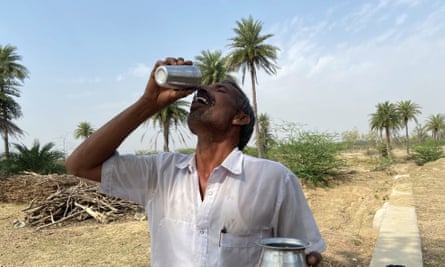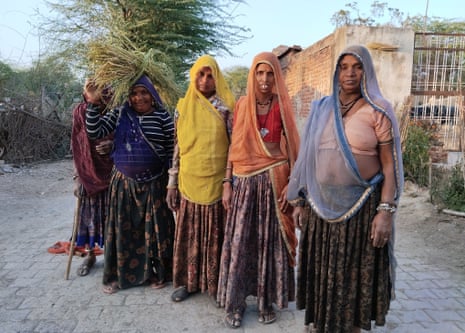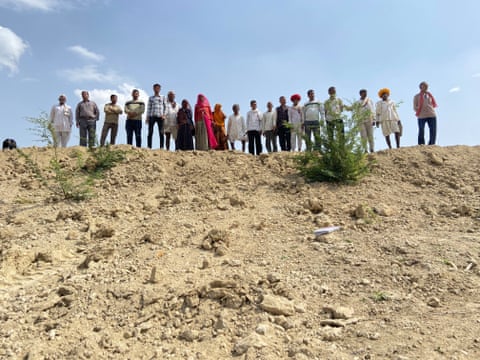The villagers of Surajpura have built a wall: a 15ft (4.5 metre) mud bulwark that snakes through barren land for nearly a mile, with an equally long trench dug beneath it. It might not look like it, but for the 650 residents who toiled on it for six months in 2022, it is an architectural marvel.
The wall passed its strength test last year when it stopped rainwater runoffs, and the trench channelled the water to parched farms in the drought-prone region of Rajasthan in north-west India, reviving them for the first time in more than two decades.
Since then, Surajpura’s residents have seen their farms come back to life, their wells refilled and the land become alive once more with migratory birds. Villagers who had left to find work have also returned to their farms.

“Our village received good rainfall until about 20 years ago” says Hemraj Sharma, standing in the middle of his lush wheat crop fed by water from a nearby well, clean enough to drink. “But major droughts and poor rain led to our wells drying up. Our farm yields hit zero. We had just one harvest cycle for years.”
“We see a drought once every three years. Last year was a drought year, too, but this time around we had water. The wall worked,” says Sharma, who worked in a textile mill in neighbouring Bhilwara city until a few years ago. The water scarcity had also led his brothers to migrate to the city, where, like him, they worked 12-hour shifts for 5,000 rupees (£50) a month.
Sharma had feared that he would lose his farmland to the climate emergency, before the entire village came together to avert the crisis. “More than 40 of the 100 wells in the village have water now,” he says.
Rajasthan, India’s largest state, is among the most vulnerable to droughts, with 98% of its 250 village blocks in sectors marked as “dark zones” – areas with dangerously low groundwater levels – and almost 7% of the land uncultivable, according to Shantanu Sinha Roy, the Rajasthan head of the Foundation for Ecological Security (FES), a land conservation organisation.
More than half of the world’s major aquifers are being depleted faster than they can be naturally replenished, the United Nations warned last year, and India is among the countries most at risk of groundwater plummeting to levels that existing wells cannot access.

In Surajpura, while rain is scarce in the sowing months of July to October, unseasonal rainfall in winter damages standing crops. Worse, the village’s poor soil quality prevents water soaking through.
For climate advocates, Surajpura’s wall is a case study in climate resilience. It was built as part of the Mahatma Gandhi National Rural Employment Guarantee Scheme (MGNREGA), a government-run social welfare policy and one of the world’s biggest job programmes. The scheme guarantees 100 days of manual labour a year to rural households that request it, and has been credited with cushioning some of the country’s poorest communities from the devastating blow of droughts and floods in the past years, as well as during the Covid-19 pandemic. But now, climate activists are increasingly citing its role in building water security in villages, amid growing climate uncertainties.
“The scheme should no longer be viewed as an instrument solely for job creation,” says Roy. “It is a climate action tool. It is the only way to protect our future.”

Surajpura is not the only community in the region that is tackling water scarcity with the help of the MGNREGA scheme. In Baldarkha village, about 10km (6 miles) from Surajpura, villagers dug contours and trenches across 8 acres (3 hectares) of barren land about three years ago turning it into a fertile grazing field for their animals – even when the ponds dried up after no rainfall last year.
In Makarya village, home to about 500 people and about 120km from Surajpura, the villagers have created another pastureland spread over 50 acres. They dug trenches and check dams on the wasteland to stop rainwater runoff and planted medicinal herbs and local tree species. The revived land has inspired a neighbouring village to utilise its wasteland in a similar fashion.
after newsletter promotion
However, there are some concerns about the scheme. Researchers say that its budgetary allocations have fallen over the past three years and its new digital system – whereby a supervisor logs attendance on a smartphone – is a stumbling block in villages with bad network, exacerbating payment delays that have affected job creation and demand.
The government has denied poor funding and says MGNREGA is a demand-driven programme, which has been granted additional funds in the past three years.
Back in Surajpura, the wheat crop sways in the breeze as villagers gather to tell the story of the wall they built. Among them is Sayari Kumavat, 50, a farmer. “I worked very hard on it,” she says. “I did get paid for each day’s labour but I also volunteered to work for free. This was going to benefit the village and me. I got water in my well.”
More rainwater seeping into the earth has recharged aquifers and improved groundwater quality, which means women in the village no longer have to make a four-hour trek to fetch water from a distant well.

Last year, the village welcomed back painted storks, migratory birds that had disappeared years ago. Several men who had moved to work in Bhilwara’s textile mills or to dig borewells in other states also returned.
Mahavir Jat, 28, worked in Jammu for six years, earning 10,000 rupees a month digging borewells. He now leases a farm and rears two buffaloes, earning 3,000 rupees a day from selling their milk. “I don’t see the need to migrate now,” he says.
Surajpura village council head, Ramlal Jat, a trained lawyer who led the wall project, says nearly 60% of the people who migrated from the village have returned. “People are investing in animals, since water and fodder are now available. We want to revive agriculture-linked livelihoods in our village.”
He is now seeking funds to strengthen the wall.
Meanwhile, farmers like Sharma have found a rare calm in their fields and a feeling of optimism. He plucks a carrot from a friend’s farm and chews on it as he speaks about the 50 quintals of wheat he reaped on his three-acre farm, the first such yield in more than two decades.
“Gajab hariyali hai (it’s amazingly green),” he says.

